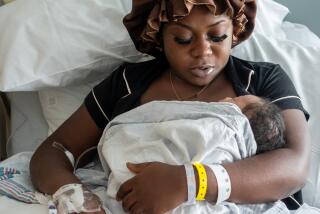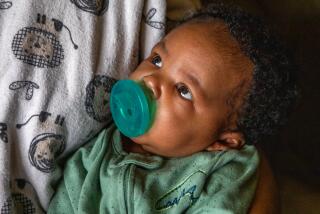Personal Health : Premature Stress-Out : Environments for ‘Preemie’ Babies Are Drawing Criticism
Anyone who has awakened to an emergency knows the feeling of being forced alert before you’re ready. The phone rings, you fumble. Someone snaps on a light, you shudder.
Imagine, then, the shock to a premature infant who is denied not hours but months of rest.
The stunned baby is rushed from a dim, muffled womb to a ward lit up day and night like an automobile showroom. Here the infant will remain anywhere from several weeks to more than three months while alarms clang, monitors beep, nurses jabber and ventilators hiss--continually. The baby’s sleep will be interrupted for various procedures an average of 40 to 132 times a day.
To the infant who has no defenses to ward off this onslaught, the neonatal intensive care unit is “basically a torture chamber,” concludes Sandra Gardner, a nurse and co-editor of the “Handbook of Neonatal Intensive Care.”
The frantic, high-tech surroundings of the neonatal nursery have, until recently, been thought necessary to saving lives. But some health care workers now argue that the environment is actually harming babies, and that infants who start their lives in neonatal intensive care may be handicapped by the experience. They may encounter feeding difficulties, inability to gain weight, disturbed sleep-wake cycles, impaired motor skills, mental disabilities and emotional problems, including lack of ability to form loving attachments.
Recent research in the new field of “environmental neonatology” found the sensory bombardment of infants may lead to hearing and vision deficits. A study published in the New England Journal of Medicine showed a link between the blazing lights used in intensive care nurseries and an illness called retinopathy of prematurity, which blinds about 500 babies annually in this country and leaves 1,500 more with some vision loss.
National Campaign
A New Jersey father, Peter Aleff, who believes his 4-year-old son’s blindness is due to light exposure in a neonatal intensive care unit, is currently waging a national campaign to have the lights reduced. But, most neonatal specialists say more study must be done before they are convinced nursery lights play a role in the disease.
Studies performed on animals also suggest that the extreme noise levels in intensive care nurseries are at least partly responsible for the high incidence of hearing loss among its graduates. Routine sounds--such as the clink of a bottle set atop the Plexiglass lid of an isolette--can register noise levels above 80 decibels inside the isolette. Levels above 80 decibels have been shown to produce hearing loss in adults.
Still other studies indicate intensive care babies may later avoid physical contact because they associate human touch with traumatic medical procedures. During their stay in intensive care, infants are handled by many different caretakers.
One neonatal specialist estimated that less than 5% of the nation’s intensive care nurseries have made substantial environmental changes on the basis of these concerns. But, in some units, nurses have taken it upon themselves to dim the lights for at least an hour or two each day to create a semblance of nighttime. And speakers that used to pump rock music to the staff are disconnected now in many nurseries in a bow to the babies’ need for quiet.
At Brigham and Women’s Hospital in Boston, a state-of-the-art environmental unit, preterm infants sleep in waterbeds and hammocks designed to simulate the contours and motion of the womb.
In this unit, alarms are set to ring at the lowest possible volumes; there are no overhead lights; and each isolette is covered with a blanket so that only about one-third of the lower porthole is exposed to light.
“We are very sensitive to having restful babies here,” said psychologist Heidelise Als, a research associate at the hospital.
Preliminary studies by Als, who is an associate professor of psychology at Harvard Medical School, show that the altered intensive care environment may reduce the amount of time an infant needs to be on an oxygen ventilator or be fed by stomach tube. She has also noted improved sleep patterns, motor functioning and attention spans in children who began life on this unit as opposed to more traditional intensive care nurseries.
Another environmentally advanced unit, the neonatal intensive care ward at Children’s National Medical Center in Washington, reflects “high-touch” as well as “high-tech values,” said Dr. Gordon Avery, chairman of the neonatology department. The hospital recently spent $150,000 to install individual dimmer switches by each isolette. (Because preemie care is already enormously costly, the expense of such alterations is often mentioned as a disincentive to environmental change.) The staff has experimented with filters that protect the isolettes from glare. And they have even tried fitting babies with special preemie sunglasses, Avery said.
Like other units that have experimented with lower lighting levels, Avery said they found that, when the lights dimmed, the staff talked more softly, and the overall atmosphere grew more peaceful.
“The more you make it like an ICU (intensive care unit), the more adults act like they’re in an ICU,” Avery said. “We need to remember this is a baby’s bedroom as well as an intensive care unit.”
Early Prototypes
The primitive prototypes of the modern neonatal intensive care unit made an attempt to duplicate the atmosphere of a baby’s bedroom, said Avery. In the introduction to the textbook “Neonatology,” he describes a premature nursery early in this century where infants were treated with warmth, rest, quiet and companionship by nurses who knitted miniature caps to keep their patients’ heads warm.
With the birth of neonatology as a highly technical subspeciality in 1975, no one got points anymore for creating a tranquil, homey atmosphere. “Survival was the outcome everyone was looking for,” said Avery. In this quest to boost survival rates, he said, concern for what the sick baby was experiencing “sort of got lost in the shuffle.”
Helen Harrison, author of “The Premature Baby Book,” said as the field matured, babies began to be treated like “physiological specimens, captive guinea pigs.”
Feeling the Pain
It got to a point where babies were being subjected to painful procedures and even surgery without benefit of anesthesia. Only recently has it begun to be generally accepted that infants do indeed need to be protected from pain.
And the intensive care infant was often denied such simple comforts as curling up in a fetal position or sucking on his or her own finger. It remains standard in hospital nurseries for babies to be immobilized on their backs, in a frog-legged position, with tubes down their throats so that crying in frustration is not an option.
With ever greater numbers of preterm infants surviving in this country--between 250,000 and 380,000 a year--the impact of the intensive care environment on its young residents will become a major source of concern in the next decade, said Dr. Joan E. Hodgman, professor of pediatrics at USC Medical School.
Yet, she said, there is not as yet sufficient data on the subject to convince most doctors to make sweeping changes. “It’s very hard to test and come up with any decent conclusions in this area,” she said.
One reason for the lack of concrete evidence is that neonatal intensive care has only existed in its present form for a little more than a decade.
And, prematurity itself puts babies at risk for complications like developmental lags and neurologic handicaps. So it becomes difficult to sort out which conditions are caused, or exacerbated, by the nursery environment and which are simply endemic to prematurity.
No Guidelines Yet
Although the American Academy of Pediatrics acknowledged last year that neonates may be adversely affected by the nursery environment, there are, so far, no widely recognized guidelines for humanizing the nursery.
The academy has made some general suggestions, such as that nursery lights be reduced from 100 foot-candles--the intensity of a bright reading light--to 60 foot-candles. Yet, that is still brighter than some factories, says Peter Aleff, the New Jersey father.
Nurses are responsible for most of the reforms on the units so far, because they are the ones who must share the space station-like environment with the preemies. “If you’re exhausted after 8 or 10 hours in there, think of what the kids feel like after months,” one nurse said.
USC professor Hodgman said, “I think the nurses are probably more ready to change the babies’ environment than the doctors.” The majority of doctors, she said, “are not doing much about it.”
Neonatal intensive care nurse Sandra Gardner said she had a “screaming, raving argument” with her co-editor, an M.D., over the inclusion of a chapter on environmental hazards in their “Handbook on Neonatal Intensive Care.” Gardner won the fight to have the chapter included, but says many physicians remain unconvinced that environmental concerns should be a priority in intensive care.
Dr. Jeffrey Pomerance, director of neonatology at Cedars-Sinai Medical Center, believes it would be dangerous for doctors to “jump on the bandwagon” and make changes, such as reducing lighting levels without further research. “If it (the environment) has really messed up people’s lives, it isn’t obvious,” he said.
Hodgman, former director of neonatology at L.A. County-USC Medical Center, which has one of the largest neonatal units in the country, agreed that reducing lights and turning down alarms could put infants at risk, particularly in larger units with a smaller staff-to-patient ratio. “You might not see things you need to see,” she said.
Advocates of nursery reform say their cause might be strengthened by more participation on the part of parents of preemies. But, parents are for the most part unaware that the intimidating physical aspect of the unit might be a problem for their babies, said Judith Sultan, founder of a San Fernando Valley support group for parents of high-risk infants.
“Parents are in crisis during the whole period (a baby is in intensive care),” Sultan said, adding that they regard the alienating nursery environment as “the price they pay for having a baby.”
A mother of premature twin girls currently resident in the intensive care nursery at Cedars-Sinai said parents can’t afford to feel critical of the intensive care nursery: “Parents are so grateful for the fact this place exists.”
Nancy Hunt said she feels confident that once her daughters leave the hospital, their years spent in a positive home environment will outweigh any negative effects of their first months in intensive care.






